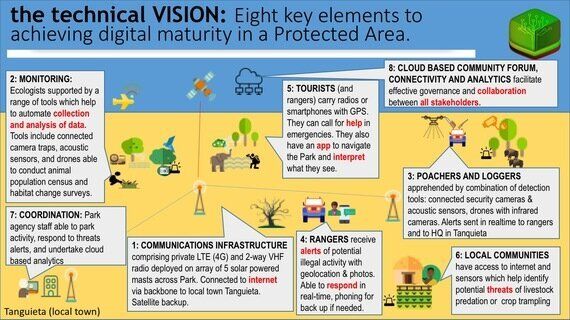There are over 200,000 protected areas (PAs) in the world as of 2014, covering 30 million km-sq - that's over 10% of our planet's land and oceans. Protecting these PAs is fundamental to the preservation of our planet's biodiversity and ecosystem.
Sadly, many of these parks are inadequately resourced and poorly managed and it often proves impossible to assess if the programmes are working. It is also difficult, given the scale of the parks and the limited ranger resources they have, for many parks to detect threats from poachers and loggers and to apprehend. It's safe to say given the statistics we're hearing that the PAs need help.
The traditional answer to these problems is to wait for more people, more funding, more equipment, improved skills. We need to be realistic how much of such scarce resources can or will be thrown at all the PAs on the planet and for this reason we turn to technology for the answer to help PAs do the job we need them to do.
There is much discussion about applications of the Internet of Things. Exhibitions, such as CES 2017, full of gadgets that no-one really needs or wants, sadly fails to show off the real value of interconnected devices. The IoT will serve a much higher purpose if it's applied correctly: IoT sensors and network technologies have the power to help us save the planet.
Africa is an obvious focal point in demonstrating how the IoT can deliver immediate benefits in wildlife conservation and the Pendjari National Park in Benin is the location of an ideal case study. The International Union for Conservation of Nature and Natural Resources (IUCN) has been working with technologists and conservationists from UK charity Smart Earth Network and IoT consultancy Eridanis to develop an IoT-based 'Digital Maturity Model' for Protected Areas such as the Pendjari Park.
This model is designed to enable PAs to assess themselves against an accepted structure and importantly, on the back of this, to establish the technology infrastructure requirement and via phased investments help them deploy it quickly and cost-effectively to achieve a full IoT capability on a shared platform.
How can the IoT make a difference?
1.Cost-effective hybrid wireless communications systems to improve park management and visitor and staff safety: A combination of inexpensive radio, private 4G and other technologies to enable voice, text and data communications which, working with GPS, can resolve these issues and enable connected devices to be deployed effectively.
2.Drone cameras and sensor based ecological monitoring: The task is today highly time consuming and produces inadequate and sporadic results. Drones with powerful cameras, connected cameras and acoustic sensors, and other tools combined with advanced analytical software, can deliver faster and better results for less effort, freeing up valuable resources for more mission critical work.
3.IoT as a decisive solution to poaching, logging and herding threats: park patrolling is inadequately resourced and unable to effectively identify and respond to threats. A combination of security cameras and acoustic sensors strategically positioned and supplemented by day and night automated drone surveillance using infrared can detect the threats readily, and send alerts to the rangers in real-time, enabling a rapid response. These solutions release rangers from time-consuming random patrolling to focus on addressing real threats.
4.Cloud-based platform and big data analysis for improved information-sharing: improves park governance and collaboration between stakeholders, from park staff, to NGOs, universities, local communities and businesses is very poor today. Combined with appropriate data storage and analytics creates the foundation for effective collaboration and knowledge-sharing.
5.IoT provides comms infrastructure to support conservation via citizen science and an improved visitor experience: Only a handful of the wealthiest parks can afford any comms infrastructure - and even then, it's focused on giving simple cellular / internet access rather than utilising visitors' data to improve park management and wildlife monitoring.
Deploying these technologies in PAs has its problems. Most PAs have no connectivity, and the tendency is to undertake piecemeal investments in standalone technologies often with expensive satellite comms. The skills to govern and manage such investments are rarely there and the initiatives that are taken often fall into disrepair.
The Smart Earth Network believes that for PAs to become effective they must achieve 'digital maturity' hence why we developed a Digital Maturity Framework. This Framework covers not only the technology but also the organisational steps necessary to create a sustainable capability which transforms the effectiveness of these vital Protected Areas in preserving our planet's biodiversity.

Image Source: Author's own (Smart Earth Network)
Readers interested in understanding more can read the public report: 'The Internet of Things for Protected Areas: The Application of Innovative Technologies to Improve Management Effectiveness, First report of IUCN Mission to Pendjari National Park' Simon Hodgkinson and Daniel Young, IUCN, 2016.
This first appeared on Smart Earth Network